Panasonic of North America APBP21 Microwave Oven User Manual F0003BP20AP En indd
Panasonic Appliance Company of America Microwave Oven F0003BP20AP En indd
User Manual
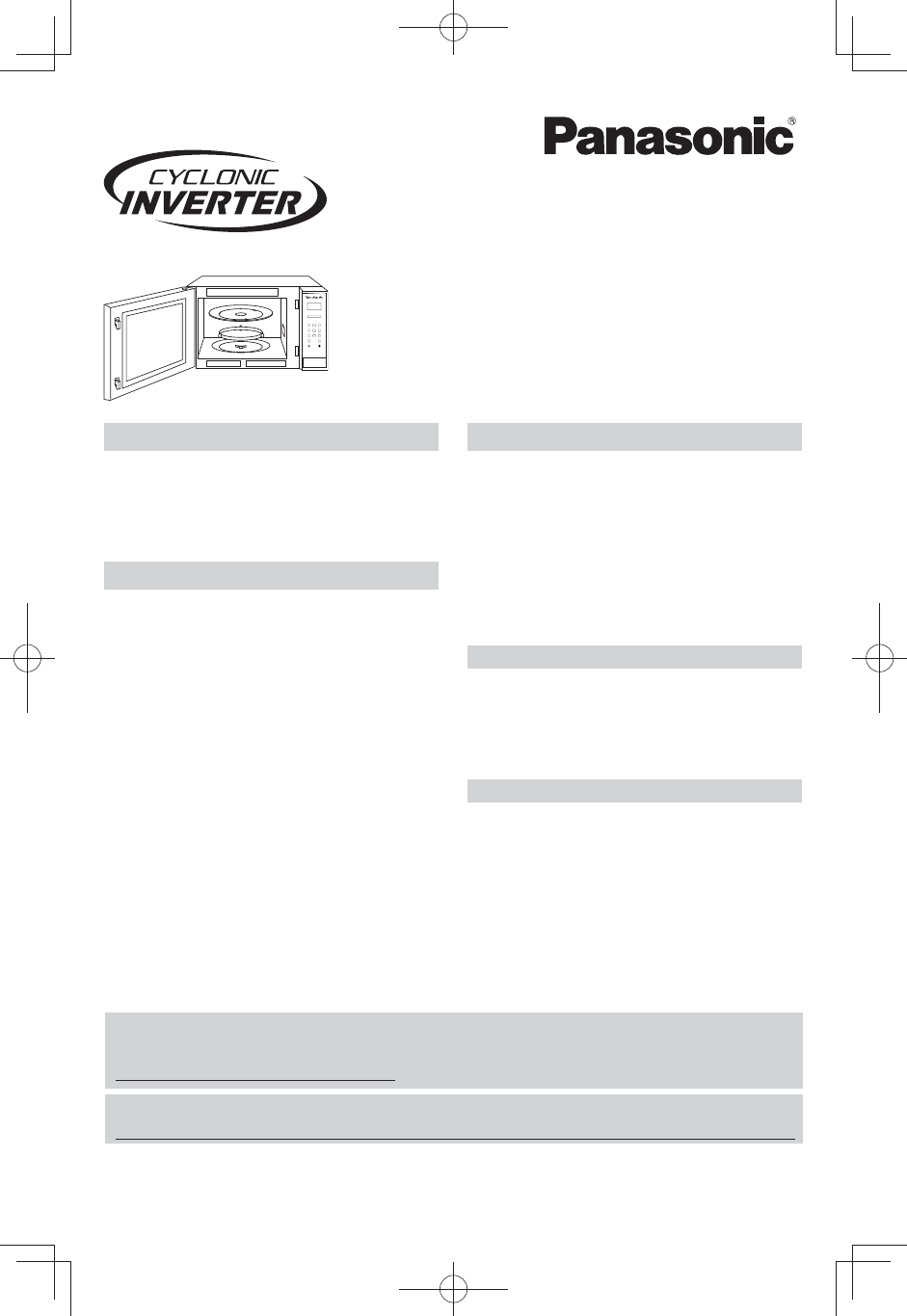
Owner’s Manual
Microwave Oven
Household Use Only
Model No. NN-SE985S
NN-SE785S
READ ALL INSTRUCTIONS CAREFULLY BEFORE USING THE OVEN.
Para instrucciones en español, voltee el libro.
For assistance, please call: 1-800-211-PANA(7262)
contact us via the web at:
http://www.us.panasonic.com/contactinfo (U.S.A and Puerto Rico)
For microwave oven safety reference, please visit FDA’s webpage at:
http://www.fda.gov/Radiation-EmittingProducts/ResourcesforYouRadiationEmittingProducts/Consumers/ucm252762.htm
F0003BP20AP
PA0215-0
Printed in China
© Panasonic Appliances Microwave Oven (Shanghai) Co., Ltd. 2015
Safety Information
Precautions ............................ Inside cover
Important Safety Instructions ............. 1-3
Installation and Grounding
instructions .......................................... 4-5
Safety Precautions .............................. 6-7
Operation
Oven Components Diagram ......................9
Control Panel ...........................................10
Starting to Use Your Oven ....................... 11
Setting the Clock ..................................... 11
Child Safety Lock.....................................11
Slider Bar .................................................12
Function Features.............................. 12-13
Selecting Power & Cook Time .................14
3-Stage Cooking ......................................14
Keep Warm Feature ................................15
Quick 30 Feature .....................................15
Coffee/Milk Feature .................................15
Popcorn Feature ......................................16
More/Less Feature ..................................16
Inverter Turbo Defrost Feature ................17
Defrosting Tips & Techniques ............ 17-18
Sensor Reheat Feature ...........................19
Operation
Sensor Cook Feature ..............................19
Sensor Cook Chart ............................ 20-21
Microwave Recipes .................................22
Timer Feature (Kitchen Timer/Stand
Time/Delay Start) .....................................23
Microwave Shortcuts ......................... 24-25
Food Characteristics................................26
Cooking Techniques .......................... 26-27
Quick Guide to Operation .................. 31-32
Maintenance
Care and Cleaning of Your Microwave
Oven ........................................................28
Accessory Purchases ..............................28
Before Requesting Service ......................29
Limited Warranty (Only for U.S.A.) ..........30
General Information
Cookware Guide ........................................8
Specifi cations ..........................................33
User’s Record ..........................................34
F0003BP20AP_En.indd 1F0003BP20AP_En.indd 1 2015/1/21 14:45:352015/1/21 14:45:35
EXHIBIT E
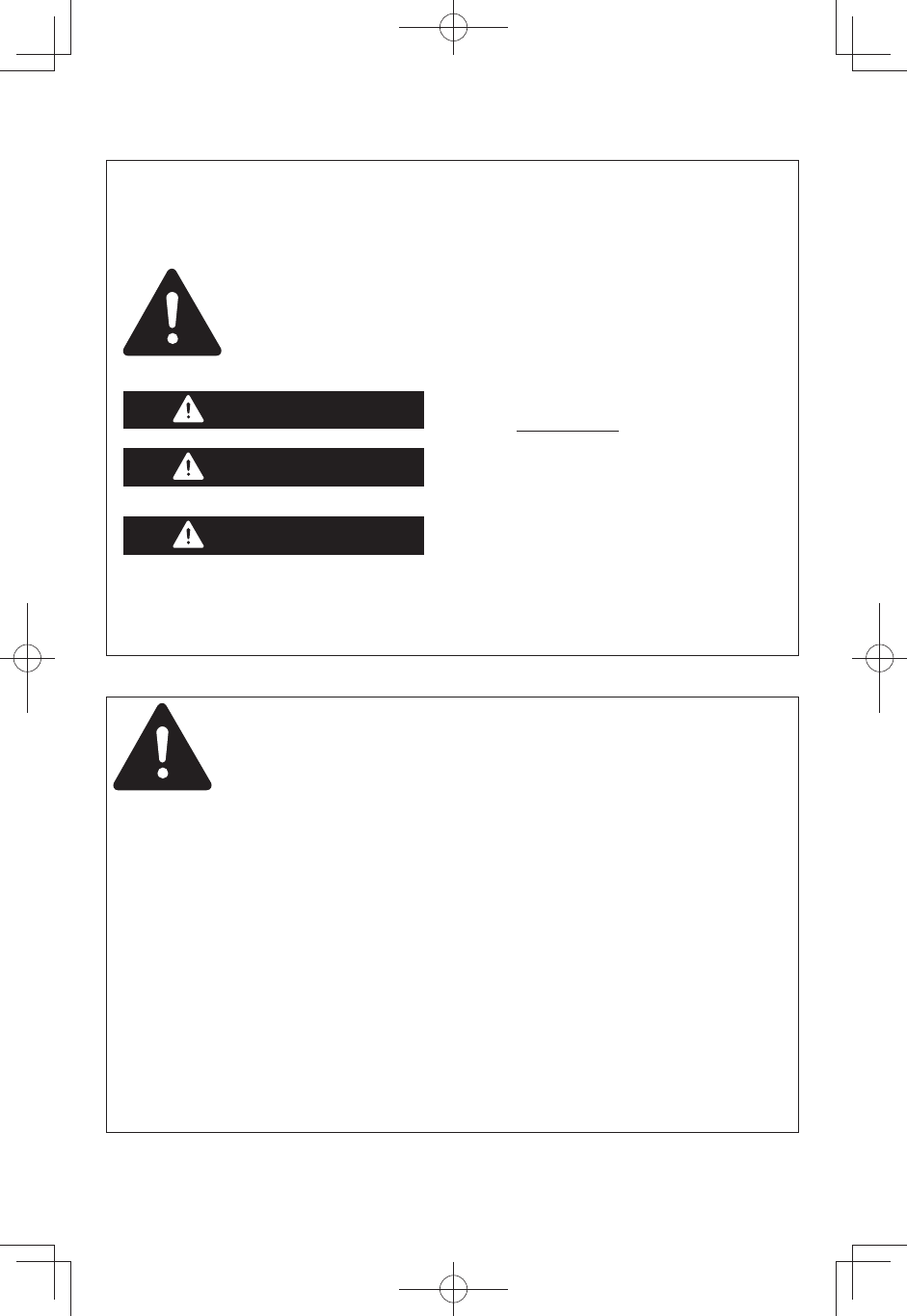
DANGER
WARNING
CAUTION
Microwave Oven Safety
Your safety and the safety of others are very important.
We have provided important safety messages in this manual and on your
appliance. Always read and obey all safety messages.
This is the safety alert symbol. It is used to alert you to poten-
tial hazards that can kill or hurt you and others.
All safety messages will follow the safety alert symbol and
either the word “DANGER”, “WARNING” or “CAUTION”. These
words mean:
You can be killed or seriously injured if
you don’t immediately follow instructions.
You can be killed or seriously injured if
you don’t follow instructions.
You can be exposed to a potentially haz-
ardous situation which, if not avoided,
may result in minor or moderate injury.
All safety messages will tell you what the potential hazard is, tell you how to
reduce the chance of injury, and tell you what can happen if the instructions
are not followed.
PRECAUTIONS TO AVOID
POSSIBLE EXPOSURE TO
EXCESSIVE MICROWAVE ENERGY
(a) Do not attempt to operate this oven with the door open since open-door
operation can result in harmful exposure to microwave energy. It is
important not to defeat or tamper with the safety interlocks.
(b) Do not place any object between the oven front face and the door or
allow soil or cleaner residue to accumulate on sealing surfaces.
(c) Do not operate the oven if it is damaged. It is particularly important that
the oven door close properly and that there is no damage to the:
(1) door (bent),
(2) hinges and latches (broken or loosened),
(3) door seals and sealing surfaces.
(d) The oven should not be adjusted or repaired by anyone except properly
qualifi ed service personnel.
F0003BP20AP_En.indd 2F0003BP20AP_En.indd 2 2015/1/21 14:45:352015/1/21 14:45:35

1
WARNING
Thank you for purchasing a Panasonic Microwave Oven.
Your microwave oven is a cooking appliance and you should use as much care as
you use with a stove or any other cooking appliance. When using electric appli-
ance, basic safety precautions should be followed, including the following:
IMPORTANT SAFETY INSTRUCTIONS
To reduce the risk of burns, electric shock, fi re, injury to persons, or exposure
to excessive microwave energy:
1. Read all instructions before using this appliance.
2. Read and follow the specifi c “PRECAUTIONS TO AVOID POSSIBLE EXPO-
SURE TO EXCESSIVE MICROWAVE ENERGY,” found on the inside front
cover.
3. This appliance must be grounded. Connect only to a properly grounded outlet.
See “GROUNDING INSTRUCTIONS” found on page 4.
4. As with any cooking appliance, DO NOT leave oven unattended while in use.
5. Install or locate this appliance only in accordance with the installation instruc-
tions found on page 4, 5.
6. DO NOT cover or block any openings on this appliance.
7. DO NOT store this appliance outdoors. DO NOT use this product near water
— for example, near a kitchen sink, in a wet basement, or near a swimming
pool or similar locations.
8. Use this appliance only for its intended use as described in this manual. DO
NOT use corrosive chemicals, vapors or non-food products in this appliance.
This type of oven is specifi cally designed to heat, or cook food.It is not de-
signed for industrial or laboratory use. The use of corrosive chemicals in heat-
ing or cleaning will damage the appliance and may result in radiation leaks.
9. When cleaning surfaces of the door and oven that come together on clos-
ing the door, use only mild, non-abrasive soaps or detergents applied with a
sponge or soft cloth.
10. DO NOT allow children to use this appliance, unless closely supervised by an
adult. DO NOT assume that because a child has mastered one cooking skill
he/she can cook everything.
11. DO NOT operate this appliance if it has a damaged cord or plug, if it is not
working properly, or if it has been damaged or dropped.
12. DO NOT immerse cord or plug in water.
13. Keep cord away from heated surfaces.
14. DO NOT let cord hang over edge of a table or counter.
15. This appliance should be serviced only by qualifi ed service personnel. Contact
the nearest authorized service center for examination, repair or adjustment.
F0003BP20AP_En.indd 1F0003BP20AP_En.indd 1 2015/1/21 14:45:352015/1/21 14:45:35

2
IMPORTANT SAFETY INSTRUCTIONS
(continued)
16. Some products such as whole eggs with or without shell, narrow neck bottles
and sealed containers — for example, closed glass jars — may explode and
should not be heated in this oven.
17. To reduce the risk of fi re in the oven cavity:
(a) DO NOT overcook food. Carefully attend appliance when paper, plastic, or
other combustible materials are placed inside the oven to facilitate cooking.
(b) Remove wire twist-ties from paper or plastic bags before placing bag in
oven.
(c) If material inside the oven ignites, keep oven door closed, turn oven
off, and disconnect the power cord, or shut off power at the fuse or
circuit breaker panel.
(d) DO NOT use the cavity for storage purposes. DO NOT leave paper prod-
ucts, cooking utensils or food in the cavity when not in use.
18. Superheated Liquids
Liquids, such as water, coffee, or tea are able to be overheated beyond the
boiling point without showing evidence (or signs) of boiling. Visible bubbling is
not always present when the container is removed from the microwave oven.
THIS COULD RESULT IN VERY HOT LIQUIDS SUDDENLY BOILING OVER
WHEN THE CONTAINER IS DISTURBED OR A UTENSIL IS INSERTED
INTO THE LIQUID.
To reduce the risk of injury to persons:
(a) STIR THE LIQUID BOTH BEFORE AND HALFWAY THROUGH HEAT-
ING IT.
(b) DO not heat water and oil, or fats together. The fi lm of oil will trap
steam, and may cause a violent eruption.
(c) DO NOT use straight-sided containers with narrow necks.
(d) After heating, allow the container to stand in the microwave oven for a
short time before removing the container.
19. DO NOT cook directly on the turntable. It can crack, cause injury or damage
to the oven.
20. For the oven designed for installation into a wall cabinet:
(a) DO NOT operate any heating or cooking appliance beneath this appliance.
(b) DO NOT mount unit over or near any portion of a heating or cooking appli-
ance.
(c) DO NOT mount over a sink.
(d) DO NOT store anything directly on the top of the appliance surface when
the appliance is in operation.
F0003BP20AP_En.indd 2F0003BP20AP_En.indd 2 2015/1/21 14:45:352015/1/21 14:45:35
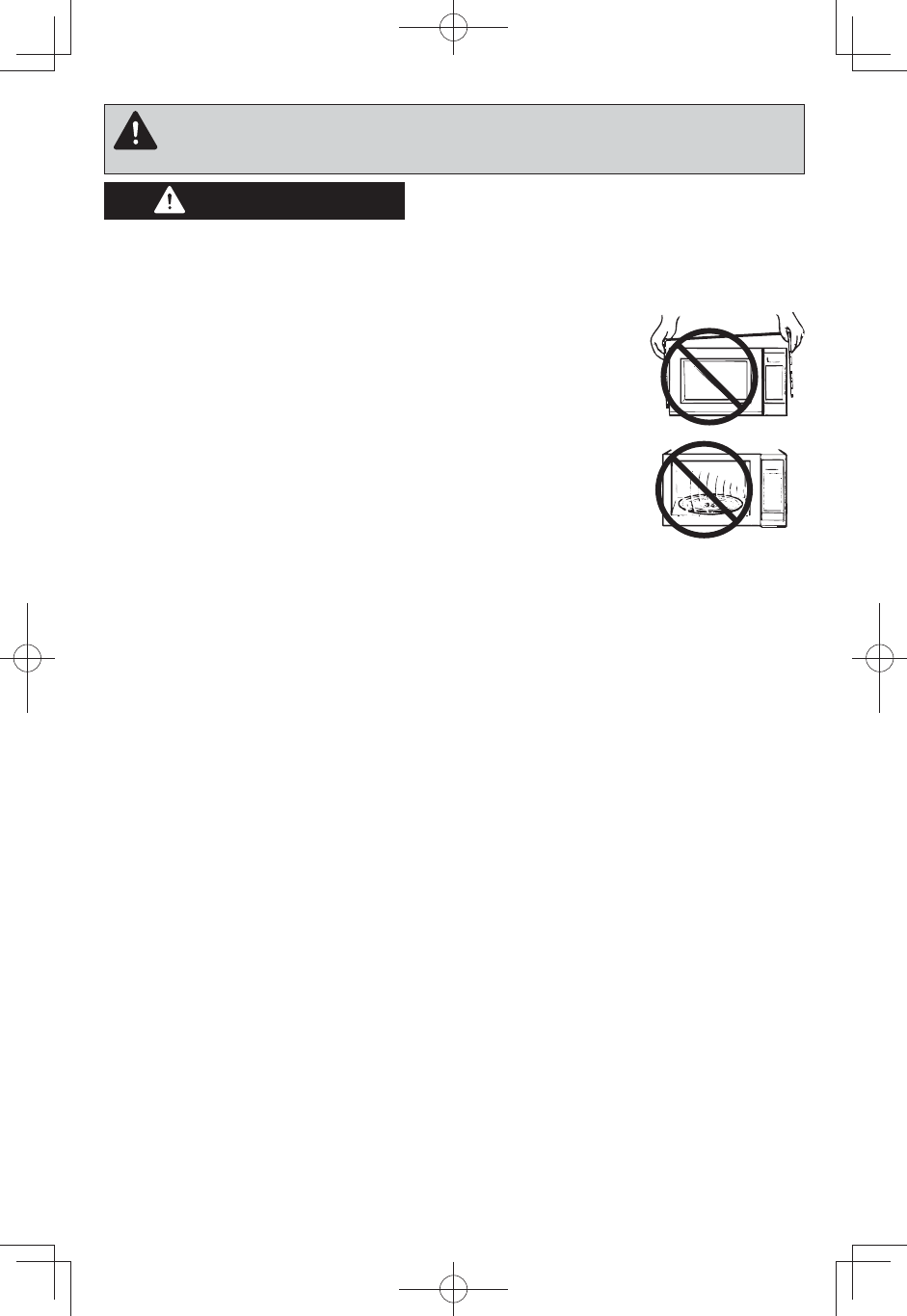
3
WARNING
IMPORTANT SAFETY INSTRUCTIONS
(continued)
TO AVOID THE RISK OF SHOCK:
DO NOT remove outer panel from oven. Repairs must be done only by a qualifi ed
service person.
TO REDUCE THE RISK OF EXPOSURE TO MICROWAVE
ENERGY:
DO NOT tamper with, or make any adjustments or repairs to Door,
Control Panel Frame, Safety Interlock Switches, or any other part
of oven, microwave leakage may result.
TO AVOID THE RISK OF FIRE:
1. DO NOT operate the microwave oven empty or use metal con-
tainers. When using the microwave oven without water or food,
microwave energy cannot be absorbed and will continuously refl ect
throughout the cavity. This will cause arcing and damage the oven
cavity, door or other components, which can lead to a fi re hazard.
2. DO NOT store fl ammable materials next to, on top of, or in the oven.
3. DO NOT dry clothes, newspapers or other materials in the oven, or use newspaper
or paper bags for cooking.
4. DO NOT hit or strike Control Panel. Damage to controls may occur.
5. DO NOT use recycled paper products unless the paper product is labeled as safe
for microwave oven use. Recycled paper products may contain impurities which may
cause sparking.
TO AVOID THE RISK OF SCALDING:
POT HOLDERS should always be used when removing items from the oven. Heat is
transferred from the HOT food to the cooking container and from the container to the Glass
Tray. The Glass Tray can also be very HOT after removing the cooking container from the oven.
SAVE THESE INSTRUCTIONS
For proper use of your oven, read remaining safety cautions and operating instructions.
Glass Tray
1. DO NOT operate the oven without the Roller Ring and the Glass Tray in place.
2. DO NOT operate the oven without the Glass Tray fully engaged on the drive hub.
Improper cooking or damage to the oven could result. Verify that the Glass Tray is
properly engaged and rotating by observing its rotation when you touch Start.
NOTE: The Glass Tray can turn in either direction.
3. Use only the Glass Tray specifi cally designed for this oven. DO NOT substitute any
other glass tray.
4. If the Glass Tray is hot, allow to cool before cleaning or placing in water.
5. DO NOT cook directly on the Glass Tray. Always place food in a microwave safe dish.
6. If food or utensils on the Glass Tray touch oven walls, causing the tray to stop mov-
ing, the tray will automatically rotate in the opposite direction.
Roller Ring
1. The Roller Ring and oven fl oor should be cleaned frequently to prevent excessive noise.
2. Always replace the Roller Ring and the Glass Tray in their proper positions.
3. The Roller Ring must always be used for cooking along with the Glass Tray.
F0003BP20AP_En.indd 3F0003BP20AP_En.indd 3 2015/1/21 14:45:352015/1/21 14:45:35

4
INSTALLATION AND GROUNDING
INSTRUCTIONS
Examine Your Oven
Unpack oven, remove all packing material and examine the oven for any damage
such as dents, broken door latches or cracks in the door. Notify dealer immedi-
ately if oven is damaged. DO NOT install if oven is damaged.
Placement of Oven
1. The oven must be placed on a fl at, stable surface. Place the front surface of
the door 3 inches (7.6 cm) or more from the counter top edge to avoid acci-
dental tipping of the microwave oven during normal use. For proper operation,
the oven must have suffi cient air fl ow. Allow 3 inches (7.6 cm) of space on both
sides of the oven and 2 inches (5 cm) of space on top of the oven.
(a) DO NOT block air vents. If they are blocked during operation, the oven may
overheat and be damaged.
(b) DO NOT place oven near a hot, damp surface such as a gas or electric
range, or dishwasher.
(c) DO NOT operate oven when room humidity is excessive.
2. This oven is manufactured for household use only. It is not approved or tested
for mobile vehicle, marine, or commercial use.
Installation
1. DO NOT block air vents. If they are blocked during operation, the oven may
overheat. If the oven overheats, a thermal safety device will turn the oven off.
The oven will remain inoperable until it has cooled.
2. If the oven is designed for installation into a wall cabinet by using the proper
trim kit available from a local Panasonic dealer, follow all instructions packed
with the kit.
WARNING
IMPROPER USE OF THE GROUNDING PLUG CAN RESULT IN A RISK OF
ELECTRIC SHOCK.
Consult a qualifi ed electrician or service person if the grounding instructions are not
completely understood, or if doubt exists as to whether the appliance is properly
grounded. If it is necessary to use an extension cord, use only a three wire extension
cord that has a three prong polarized grounding plug, and a three slot receptacle that
will accept the plug on the appliance. The marked rating of the extension cord should
be equal to or greater than the electrical rating of the appliance.
Grounding Instructions
THIS APPLIANCE MUST BE GROUNDED. In the event of an electrical short
circuit, grounding reduces the risk of electric shock by providing an escape wire for
the electric current. This appliance is equipped with a cord having a grounding wire
with a grounding plug. The plug must be plugged into an outlet that is properly
installed and grounded.
• Plug into properly installed and grounded 3 prong outlet.
• DO NOT remove ground prong.
• DO NOT use an adapter.
F0003BP20AP_En.indd 4F0003BP20AP_En.indd 4 2015/1/21 14:45:352015/1/21 14:45:35

5
INSTALLATION AND GROUNDING
INSTRUCTIONS (continued)
Power supply
1. A short power-supply cord is provided to reduce the risks resulting from becoming
entangled in or tripping over a longer cord.
2. Longer cord sets or extension cords are available and may be used if care is exer-
cised in their use. DO NOT let cord hang over edge of a table or counter.
3. If a long cord or extension cord is used, (1) the marked electrical rating of the cord
set or extension cord should be at least as great as the electrical rating of the
appliance, (2) the extension cord must be a grounding-type 3-wire
cord, and (3) the longer cord should be arranged so that it will not
drape over the counter top or tabletop where it can be pulled on by
children or tripped over accidentally.
Wiring requirements
The oven must be operated on a SEPARATE CIRCUIT. No other appliance should
share the circuit with the microwave oven. If it does, the branch circuit fuse may blow
or the circuit breaker may trip. The oven must be plugged into at least a 20 AMP,
120 VOLT, 60 Hz GROUNDED OUTLET. Where a standard two-prong outlet is en-
countered, it is the personal responsibility and obligation of the consumer to have it
replaced with a properly grounded three-prong outlet. The VOLTAGE used must be
the same as specifi ed on this microwave oven (120 V, 60 Hz). Using a higher volt-
age is dangerous and may result in a fi re or oven damage. Using a lower voltage will
cause slow cooking. Panasonic is NOT responsible for any damages resulting from
the use of the oven with any voltage other than specifi ed.
TV / RADIO / WIRELESS EQUIPMENT INTERFERENCE
1. Operation of the microwave oven may cause interference to your radio, TV, Wi-Fi,
cordless telephone, baby monitor, blue tooth, or other wireless equipment.
2. When there is interference, it may be reduced or eliminated by taking the following
measures:
(a) Place the radio, TV, etc. away from the microwave oven as far as possible.
(b) Use a properly installed antenna to obtain stronger signal reception.
(c) Clean door and sealing surfaces of the oven. (See Care and Cleaning of Your
Microwave Oven)
F0003BP20AP_En.indd 5F0003BP20AP_En.indd 5 2015/1/21 14:45:352015/1/21 14:45:35

6
Follow These Safety Precautions When Cooking in Your Oven.
IMPORTANT
Proper cooking depends upon the power, the time setting and quantity of
food. if you use a smaller portion than recommended but cook at the time
for the recommended portion, fi re could result.
1) HOME CANNING / STERILIZING / DRYING FOODS /
SMALL QUANTITIES OF FOODS
• DO NOT use your oven for home canning. Your oven cannot maintain the food at
the proper canning temperature. The food may be contaminated and then spoil.
• DO NOT use the microwave oven to sterilize objects (baby bottles, etc.). It is dif-
fi cult to keep the oven at the high temperature needed for sterilization.
• DO NOT dry meats, herbs, fruits or vegetables in your oven. Small quantities
of food or foods with low moisture content can dry out, scorch or catch on fi re if
overheated.
2) POPCORN
Popcorn may be popped in a microwave oven corn popper. Microwave pop-
corn which pops in its own package is also available. Follow popcorn manu-
facturers' directions and use a brand suitable for the cooking power of your
microwave oven.
CAUTION: When using pre-packaged microwave popcorn, you can follow
recommended package instructions or use the popcorn pad (refer to page 16).
Otherwise, the popcorn may not pop adequately or may ignite and cause a
fi re. Never leave oven unattended when popping popcorn. Allow the popcorn
bag to cool before opening, always open the bag facing away from your face
and body to prevent steam burns.
3) DEEP FAT FRYING
• DO NOT deep fat fry in your microwave oven. Cooking oils may burst into fl ames
and may cause damage to the oven and perhaps result in burns. Microwave
utensils may not withstand the temperature of the hot oil, and can shatter or melt.
4) FOODS WITH NONPOROUS SKINS
• DO NOT COOK/REHEAT WHOLE EGGS, WITH OR WITHOUT THE SHELL.
Steam buildup in whole eggs may cause them to explode, and possibly dam-
age the oven or cause injury. Reheating SLICED hard-boiled eggs and cooking
SCRAMBLED eggs is safe.
• Potatoes, apples, whole squash and sausages are examples of foods with
nonporous skins. These types of foods must be pierced before microwave cook-
ing to prevent them from exploding.
CAUTION: Cooking dry or old potatoes can cause fi re.
Safety Precautions
F0003BP20AP_En.indd 6F0003BP20AP_En.indd 6 2015/1/21 14:45:352015/1/21 14:45:35
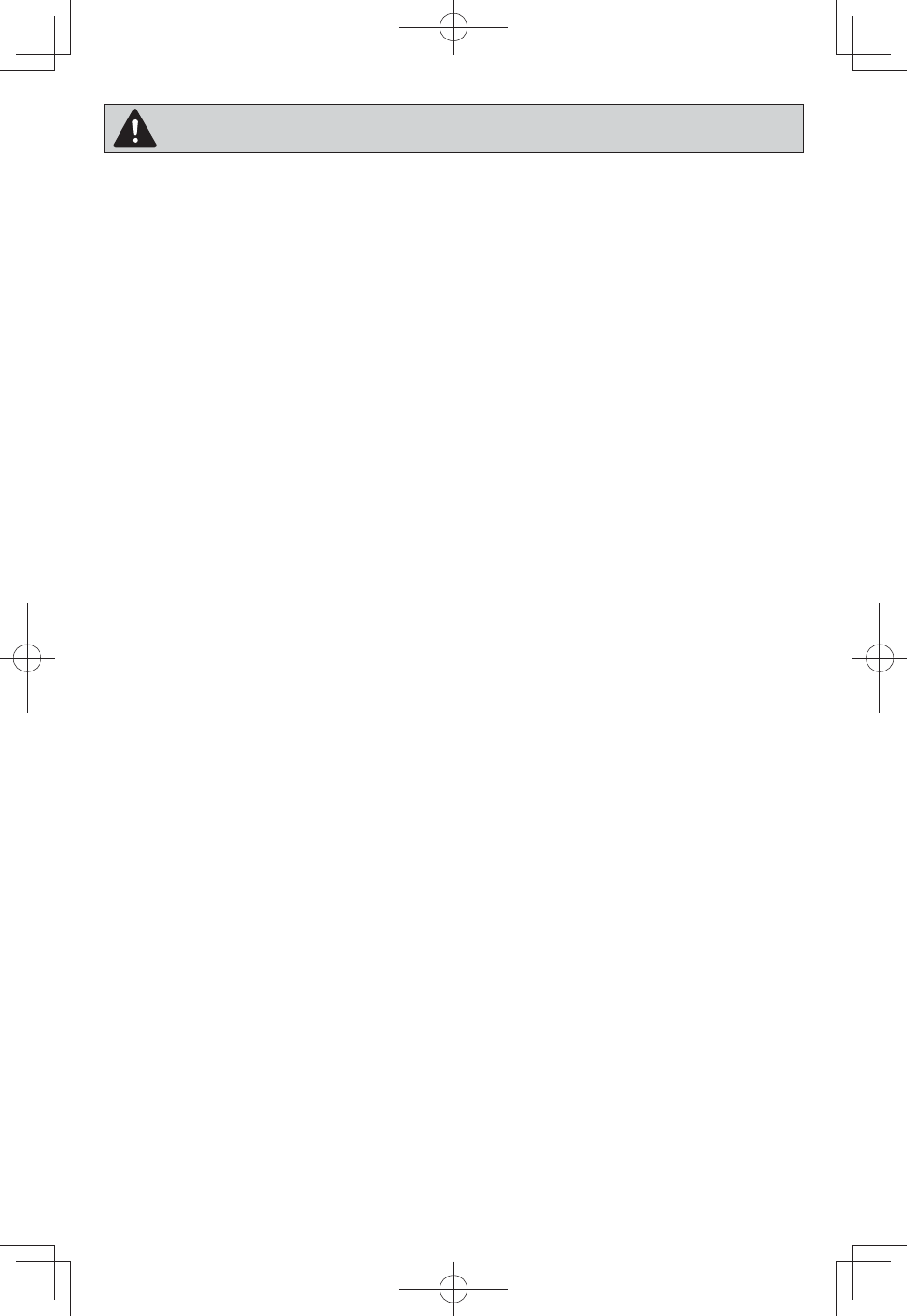
7
5) GLASS TRAY / COOKING CONTAINERS / FOIL
• Cooking containers get hot during microwaving. Heat is transferred from the
HOT food to the container and the Glass Tray. Use pot holders when remov-
ing containers from the oven or when removing lids or plastic wrap covers from
cooking containers, to avoid burns.
• The Glass Tray will get hot during cooking. It should be allowed to cool before
handling or before paper products, such as paper plates or microwave popcorn
bags, are placed in the oven for microwave cooking.
• When using foil in the oven, allow at least 1-inch (2.5 cm) of space between foil
and interior oven walls or door.
• Dishes with metallic trim should not be used, as arcing may occur.
6) PAPER TOWELS / CLOTHS
• DO NOT use paper towels or cloths which contain a synthetic fi ber woven into
them. The synthetic fi ber may cause the towel to ignite. Use paper toweling un-
der supervision.
7) BROWNING DISHES / OVEN COOKING BAGS
• Browning dishes or grills are designed for microwave cooking only. Always follow
instructions provided by the manufacturer. DO NOT preheat browning dish more
than 6 minutes.
• If an oven cooking bag is used for microwave cooking, prepare according to
package directions. DO NOT use a wire twist-tie to close bag, instead use plastic
ties, cotton string or a strip cut from the open end of the bag.
8) THERMOMETERS
• DO NOT use a conventional meat thermometer in your oven. Arcing may occur.
Microwave safe thermometers are available for both meat and candy.
9) BABY FORMULA / BABY FOOD
• DO NOT heat baby formula or baby food in the microwave oven. The glass jar or
surface of the food may appear warm while the interior can be so hot as to burn
the infant’s mouth and esophagus.
10) REHEATING PASTRY PRODUCTS
• When reheating pastry products, check temperatures of any fi llings before eat-
ing. Some foods have fi llings which heat faster and can be extremely hot, while
the surface remains warm to the touch (ex. Jelly Donuts).
11) GENERAL OVEN USAGE GUIDELINES
• DO NOT use the oven for any purpose other than the preparation of food.
Safety Precautions (continued)
F0003BP20AP_En.indd 7F0003BP20AP_En.indd 7 2015/1/21 14:45:352015/1/21 14:45:35
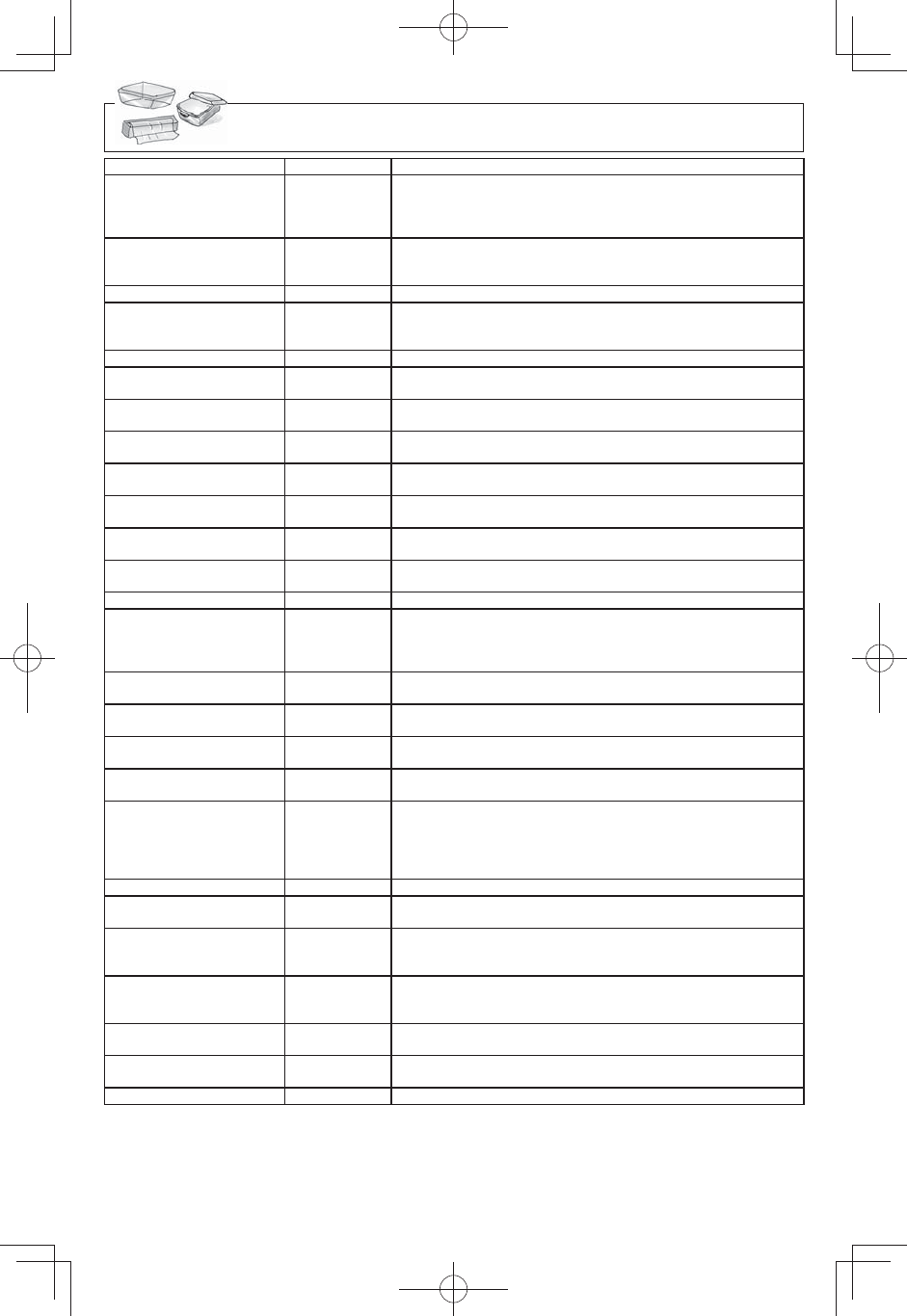
8
Cookware Guide
ITEM MICROWAVE COMMENTS
Aluminum Foil
Yes for
Shielding
only
Small strips of foil can be molded around thin parts of meat
or poultry to prevent overcooking. Arcing can occur if foil is
too close to oven wall or door and damage to your oven will
result.
Browning Dish Yes
Browning dishes are designed for microwave cooking only.
Check browning dish information for instructions and heat-
ing chart. Do not preheat for more than 6 minutes.
Brown paper bags No May cause a fi re in the oven.
Dinnerware:
Labeled
“Microwave Safe”
Yes
Check manufacturers' use and care directions for use in mi-
crowave heating. Some dinnerware may state on the back
of the dish, “Oven-Microwave Safe”.
Unlabeled Dinnerware ? Use CONTAINER TEST below.
Disposable polyester
Paperboard Dishes Yes Some frozen foods are packaged in these dishes. Can be
purchased in grocery stores.
Fast Food Carton
with Metal Handle No Metal handle may cause arcing.
Frozen Dinner Tray
Metal No Metal can cause arcing and damage to your oven.
Frozen Dinner Tray
Microwave safe Yes Heat only 1 tray in the oven at one time.
Glass Jars No Most glass jars are not heat resistant. Do not use for cook-
ing or reheating.
Heat Resistant Oven
Glassware & Ceramics Yes Ideal for microwave cooking and browning.
(See CONTAINER TEST below)
Metal Bakeware No Not recommended for use in microwave ovens. Metal can
cause arcing and damage to your oven.
Metal Twist-Ties No May cause arcing which could cause a fi re in the oven.
Oven Cooking Bag Yes
Follow manufacturers' directions. Close bag with the nylon
tie provided, a strip cut from the end of the bag, or a piece
of cotton string. Do not close with metal twist-tie. Make six
½-inch (1 cm) slits near the closure.
Paper Plates & Cups Yes Use to warm cooked foods, and to cook foods that require
short cooking times such as hot dogs.
Paper Towels & Napkins Yes Use to warm rolls and sandwiches, only if labeled safe for
microwave use.
Recycled Paper Towels
& Napkins No Recycled paper products may contain impurities which may
cause sparks.
Parchment Paper Yes Use as a cover to prevent spattering. Safe for use in micro-
wave, microwave/convection and conventional ovens.
Plastic:
Microwave Safe
Cookware Yes
use caution
Should be labeled, "Suitable for Microwave Heating." Check
manufacturers’ directions for recommended uses.
Some microwave safe plastic containers are not suitable for
cooking foods with high fat or sugar content. The heat from
hot food may cause the plastic to warp.
Plastic, Melamine No This material absorbs microwave energy. Dishes get HOT!
Plastic Foam Cups Yes
use caution
Plastic foam will melt if foods reach a high temperature.
Use to reheat foods to a low serving temperature only.
Plastic Wrap Yes
Use to cover food during cooking to retain moisture and
prevent spattering. Should be labeled “Suitable for Micro-
wave Heating”. Check package directions.
Straw, Wicker, Wood Yes
use caution
Use only for short term reheating and to bring food to a low
serving temperature. Wood may dry out & split or crack
when used.
Thermometers-
Microwave safe Yes Use only microwave safe meat and candy thermometers.
Thermometers-
Conventional No Not suitable for use in microwave oven, will cause sparks
and get hot.
Wax paper Yes Use as a cover to prevent spattering and to retain moisture.
CONTAINER TEST
TO TEST A CONTAINER FOR SAFE MICROWAVE OVEN USE: Fill a microwave safe cup with cool
water and place it in the microwave oven alongside the empty container to be tested; heat one (1)
minute at P10 (HIGH). If the container is microwave oven safe (transparent to microwave energy), the
empty container should remain comfortably cool and the water should be hot. If the container is hot, it
has absorbed some microwave energy and should NOT be used. This test cannot be used for plastic
containers.
F0003BP20AP_En.indd 8F0003BP20AP_En.indd 8 2015/1/21 14:45:352015/1/21 14:45:35
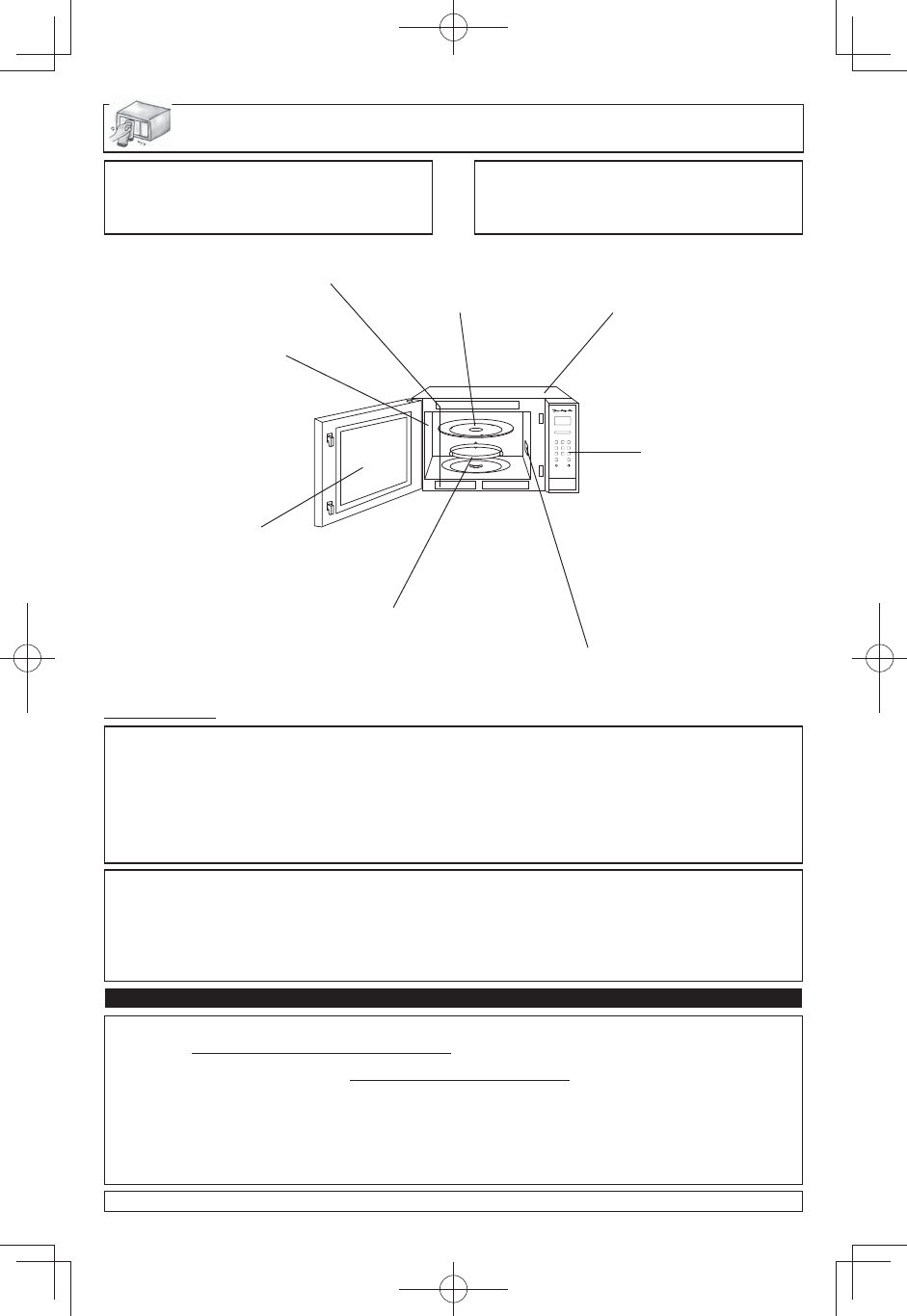
28
Care and Cleaning of Your Microwave Oven
BEFORE CLEANING:
Unplug oven at wall outlet. If outlet is inacces-
sible, leave oven door open while cleaning.
AFTER CLEANING:
Be sure to place the Roller Ring and the
Glass Tray in the proper position and touch
Stop/Reset Pad to clear the Display.
Label:
Do not remove, wipe with a damp
cloth.
Inside of the oven:
Wipe with a damp cloth
after using. Mild detergent
may be used if needed.
Do not use harsh deter-
gents or abrasives.
Oven Door:
Wipe with a soft dry
cloth when steam
accumulates inside or
around the outside of
the oven door. During
cooking, especially
under high humid-
ity conditions, steam
is given off from the
food. (Some steam will
condense on cooler
surfaces, such as the
oven door. This is
normal.)
Inside surface is
covered with a heat
and vapor barrier fi lm.
Do not remove.
Roller Ring and oven cavity fl oor:
Clean the bottom surface of the oven
with mild detergent water or window
cleaner, and dry. Roller Ring may be
washed in mild soapy water or dish-
washer. These areas should be kept
clean to avoid excessive noise.
Do not remove wave guide cover:
It is important to keep cover
clean in the same manner as the
inside of the oven.
Glass Tray:
Remove and wash in
warm soapy water or in
a dishwasher.
Outside oven surfaces:
Clean with a damp cloth.
To prevent damage to the
operating parts inside the
oven, water should not be
allowed to seep into ventila-
tion openings.
Control Panel:
* Covered with a
removable protective
fi lm to prevent
scratches during
shipping. Small
bubbles may appear
under this fi lm. (Hint -
To remove fi lm, apply
masking or clear tape
to an exposed corner
and pull gently.)
* If the Control Panel
becomes wet, clean
it with a soft dry cloth.
Do not use harsh de-
tergents or abrasives.
IT IS IMPORTANT TO KEEP THE OVEN CLEAN AND DRY.
FOOD RESIDUE AND CONDENSATION MAY CAUSE RUSTING
OR ARCING AND DAMAGE TO THE OVEN. AFTER USE, WIPE
DRY ALL SURFACES-INCLUDING VENT OPENINGS, OVEN
SEAMS, AND UNDER GLASS TRAY.
PARTS DESCRIPTION PART NUMBER
Instructions / Operating Manual (this book) F003BP20AP
Glass Tray A06014M00AP (NN-SE985S)
A06014A00AP (NN-SE785S)
Roller Ring Assembly F290D9R00AP (NN-SE985S)
F290DBP20AP (NN-SE785S)
Accessory Purchases (United States and Puerto Rico)
Purchase Parts, Accessories and Owner's Manual online for all Panasonic Products by visiting our
Web Site at: http://www.pstc.panasonic.com
Or, send your request by E-mail to: npcparts@us.panasonic.com
You may also contact us directly at:
1-800-332-5368 (Phone) 1-800-237-9080 (Fax Only) (Monday-Friday 9am-9pm EST)
Panasonic National Parts Center
20421 84th Avenue South
Kent, WA 98032
(We accept Visa, MasterCard, Discover Card, American Express)
For hearing or speech impaired TTY users, TTY: 1-866-605-1277
F0003BP20AP_En.indd 28F0003BP20AP_En.indd 28 2015/1/21 14:45:382015/1/21 14:45:38
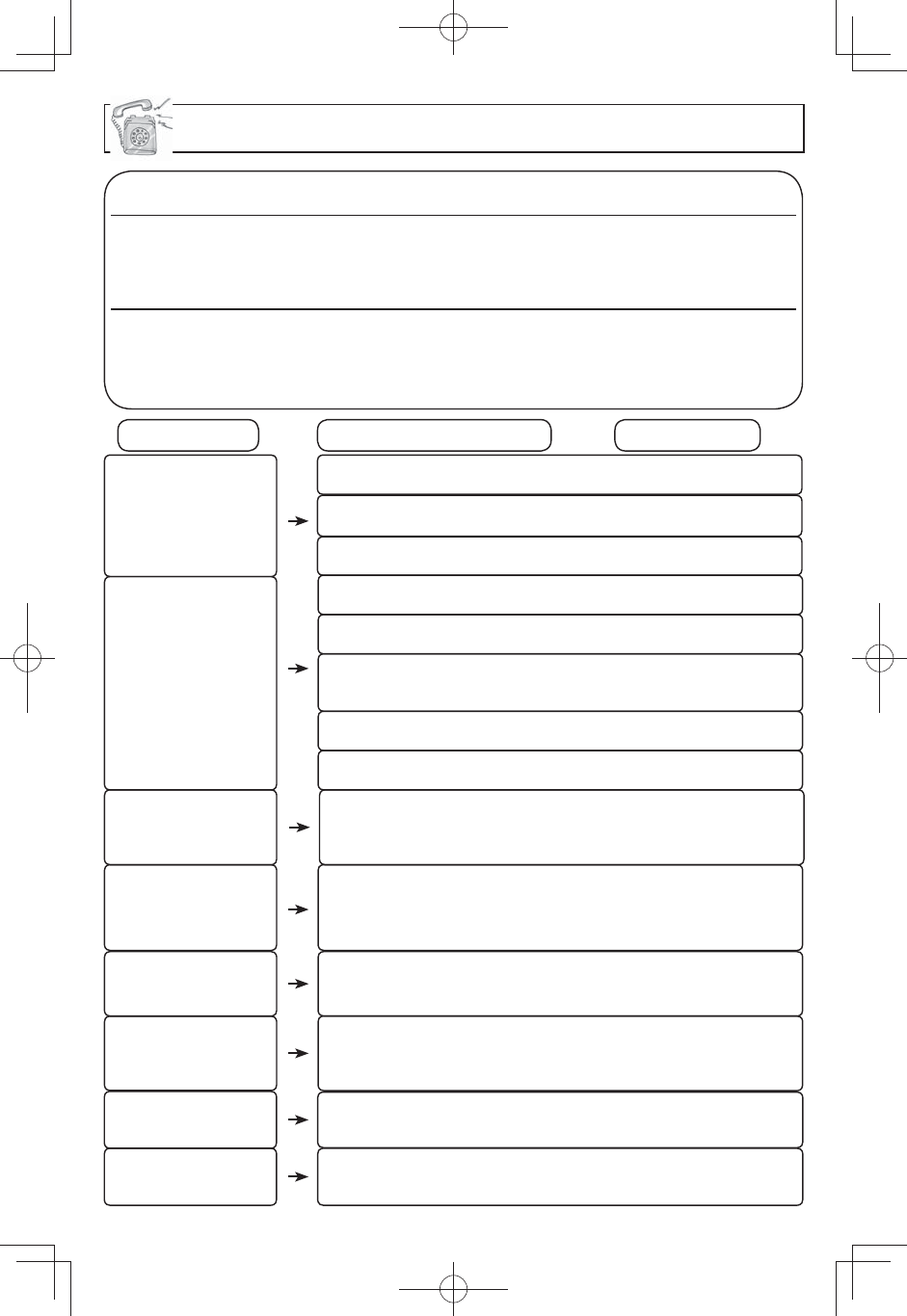
29
Before Requesting Service
The oven is not plugged in se-
curely.
Remove plug from outlet, wait 10
seconds and re-insert.
Main circuit breaker or main fuse
is tripped or blown.
Reset main circuit breaker or re-
place main fuse.
The door is not closed
completely.
Close the oven door securely.
Start Pad was not touched after
programming.
Touch Start Pad.
The program is not correct. Program again according to the
Operating Instructions.
Stop/Reset Pad has been
touched accidentally.
Program oven again.
Another program is already en-
tered into the oven.
Touch Stop/Reset Pad to cancel
the previous program and enter
new program.
There is a problem with the out-
let.
Plug another appliance into the
outlet to check if it is working.
PROBLEM POSSIBLE CAUSE REMEDY
Oven will not turn on.
Oven will not start
cooking.
The Glass Tray is not
positioned properly on the Roller
Ring or there is food under the
Roller Ring.
Take out Glass Tray and Roller
Ring. Wipe with a damp cloth and
reset Roller Ring and Glass Tray
properly.
The Glass Tray
wobbles.
The Roller Ring and oven
bottom are dirty.
Clean these parts according to
Care and Cleaning of your
Microwave oven (see page 28).
When the oven is
operating, there is
noise coming from
the glass tray.
The CHILD LOCK was
activated.
Deactivate LOCK by touching Stop/
Reset Pad 3 times.
The word “LOCK”
appears in the display
window.
This displaying indicates a prob-
lem with the microwave genera-
tion system.
Please contact an authorised Ser-
vice Center (see page 30).
The oven stops cook-
ing and “H00”, “H97” or
“H98” appears in the
display window.
The oven may be in stand-by
mode.
Ensure the oven is plugged
in. Open and close the door to
activate.
The control panel keys
do not respond when
touched.
Demo mode was selected “On”. Deactivate mode by touching
Power Level key once Start Key 4
times and Stop/Reset Key 4 times.
The word “DEMO
MODE” appears in the
display Window.
These things are normal:
The oven causes in-
terference with my TV.
Some radio, TV, Wi-Fi, cordless telephone, baby monitor, blue tooth
or other wireless equipment interference might occur when you
cook with the microwave oven. This interference is similar to the
interference caused by small appliances such as mixers, vacuums,
blow dryers, etc. It does not indicate a problem with your oven.
Steam accumulates
on the oven door and
warm air comes from
the oven vents.
During cooking, steam and warm air are given off from the food.
Most of the steam and warm air are removed from the oven by
the air which circulates in the oven cavity. However, some steam
will condense on cooler surfaces such as the oven door. This is
normal. After use, the oven should be wiped dry (see page 28).
F0003BP20AP_En.indd 29F0003BP20AP_En.indd 29 2015/1/21 14:45:382015/1/21 14:45:38
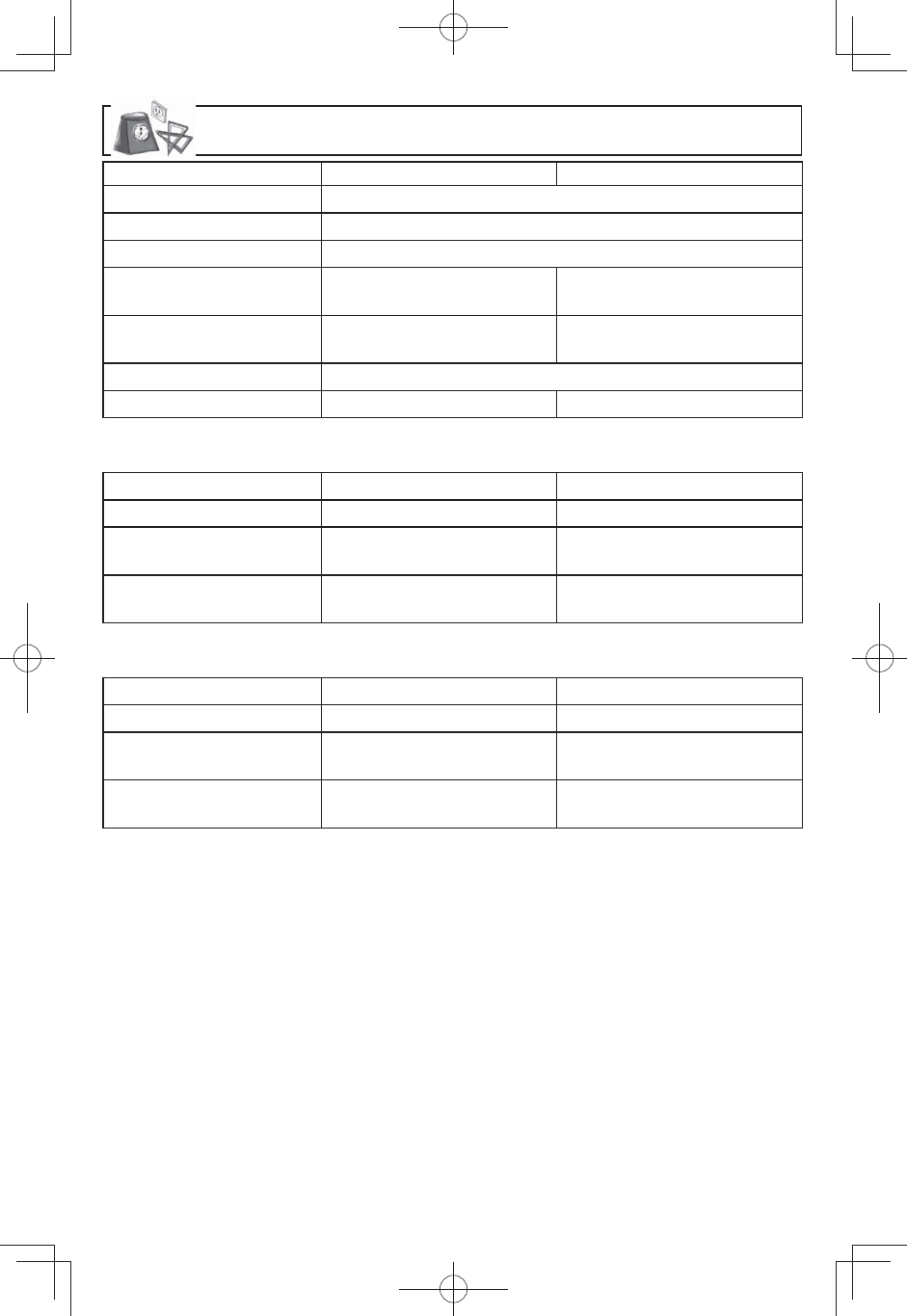
33
Specifi cations
NN-SE985S NN-SE785S
Power Source: 120 V 60 Hz
Power Consumption: 12.3 A 1,460 W
Cooking Power:* 1,250 W
Outside Dimensions
(W x H x D):
23 /” x 14” x 19 /”
(606 mm x 356 mm x 493 mm)
21 /” x 11 /” x 19 /”
(555 mm x 304 mm x 493 mm)
Oven Cavity Dimensions
(W x H x D):
17 /” x 10 /” x 18 ½”
(449 mm x 274 mm x 470 mm)
15 /” x 8 /” x 18 ½”
(398 mm x 210 mm x 470 mm)
Operating Frequency: 2,450 MHz
Net Weight: Approx. 36.8 lbs. (16.7 kg) Approx. 31.5 lbs. (14.3 kg)
Trim Kit for 27” Cabinet:
NN-SE985S NN-SE785S
Model Number: NN-TK922S NN-TK722S
Outside Dimensions
(W x H):
27” x 18 ⁄”
(684 mm x 472 mm)
27” x 16 ½ ”
(684 mm x 419 mm)
Cabinet Opening
(W x H x D):
25 /” x 17 /” x 21”
(648 mm x 442 mm x 533 mm)
25 /” x 15 /” x 21”
(648 mm x 389 mm x 533 mm)
Trim Kit for 30” Cabinet:
NN-SE985S NN-SE785S
Model Number: NN-TK932S NN-TK732S
Outside Dimensions
(W x H):
30” x 18 ⁄”
(760 mm x 472 mm)
30” x 16 ½ ”
(760 mm x 419 mm)
Cabinet Opening
(W x H x D):
28 /” x 17 /” x 21”
(724 mm x 442 mm x 533 mm)
28 /” x 15 /” x 21”
(724 mm x 389 mm x 533 mm)
*IEC Test procedure Specifi cations subject to change without notice.
F0003BP20AP_En.indd 33F0003BP20AP_En.indd 33 2015/1/21 14:45:392015/1/21 14:45:39